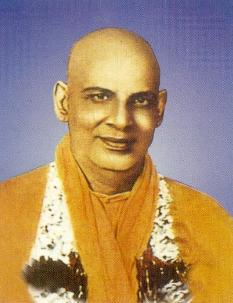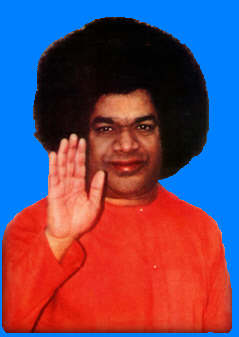| |
Sri Sathya Sai Baba and Swami Sivananda
"Sri Satya Sai Baba of Andhra
Pradesh, also visited the Master [Swami Sivananda]. Materialising
a rudrakasha mala with gold links, he lovingly presented it
to the Master."
From:
Sivananda's Personality
- By
Sri
N. Ananthanarayanan
http://www.dlshq.org/saints/sivaperson.htm
 |
 |
| Sri Swami Sivananda Saraswati |
Sri Sathya Sai Baba |
Sai Baba - Trip to Rishikesh
On the twenty-second of July (year 1957) Baba left New Delhi by car
for Rishikesh. When he reached Sivanandanagar at 6:30 that evening,
Swami Sivananda called a special gathering of the disciples of the
Ashram and offered Baba a hearty welcome.
Swami Sadananda (one of the senior disciples) was, prior to his
entering the monastery, a professor of history at the Presidency
College, Madras. Saivism, a school of philosophy and worship, that
highlighted the Siva (Shiva) aspect of Godhead, was his favourite
subject of study, and Baba had prodded him to explain the
significance of the Linga. Baba explained that it represented the
emergence of the Cosmos from the formless as well as the mergence of
the Cosmos into the formless. "The sun appears as a huge red disc
when it rises and when it sets", said Baba.
"This is a revelation to me on my New Year Day," the Sanyasin said.
"It is now many years since you celebrated new Year. You were in the
midst of your family then. Now you are in the Sai Family. So, here,
take this.!" Baba said, while waving his palm. An "Obbattu", a sweet
dish traditionally prepared in Tamil homes on New Year Day was
resting on that palm - hot, fragrant with ghee (butter), thick,
circular, with a sprinkle of sugar! My mouth watered, the ascetic
Sadananda helt out his hand. Seeing my plight, Baba waved again, to
project a second Obbattu for me too.
Swami Sivananda (founder of the Ashram) was the very embodiment of
equanimity. In the midst of vociferous pleadings and protestations
from visitors and inmates, he was being pushed around by his
disciples in a wheeled chair.
Sivanandanagar (the tranquil and holy ashram of Swami Sivananda)
nestles on the lap of the evergreen mountains, banked lovingly by
the kindly right arm of Mother Ganges. The left bank of the river,
when it comes into view occasionally as the curtain of mist is
wafted away, is resplendent with a line of temples and edifices
housing three hermitages. More impressive than these are the forest-clad mountains on every side that seem like superhuman sages lost in
silent contemplation of the Infinite.
The Ganges, daughter of the earth and sky, famed in lore and legend,
sought after by devotees in every Hindu home for thousands of years
to sanctify every ritual... rolls majestically by, reminding
everyone of India's message and India's grandeur. When the students
of the hermitage arranged a gathering of devotees the next day, and
requested Baba to give them a message, he referred to the Ganges,
comparing it to a sincere seeker of God speeding to the sea. He said
that every river knows that it has come from the sea and it is
prompted by that knowledge to hurry back toward the sea.
Speaking of the things that he is accustomed to make and give, Sai
Baba discounted all spurious explanations and said that his will is
immediately fulfilled. He materializes things to give joy to his
devotees, just as a father gives sweets to his little ones, not to
advertise his generosity or parenthood.
He then materialized by the mere wave of his hand a magnificent
Rudraksha garland of 108 beads, a rosary made from a berry. It was
of exquisite workmanship, each bead encased in gold, and all were
strung in gold with a five faced king-bead in the center. He
presented it to Swami Sivananda. He also manifested a large quantity
of sacred ash and applied it to the sage's forehead. That evening when the Swami entered the Satsang Hall wearing the unique garland,
everyone was awed by its luster and workmanship and the miracle that
brought it forth.
Baba's speeches and conversation were so full of rare and deep
wisdom that the next day a number of senior monks and neophytes came
to see Baba and plied him with questions designed to clarify their
doubts. Swamis Sadananda and Satchidananda found themselves
surrounded by eager inquirers wanting more and more information
about Baba, his life, his glory, and his Prasanthi Nilayam (abode of
great peace) at Puttaparthi. Swami Sadananda told a young
Brahmachari that Baba can roam at will through the regions of the
soul, the supersoul, and the oversoul, and can reveal whatever
happens anywhere at any time. He also said he is all-powerful and
had seen Baba converting a grain of rice into a grain of ivory and
transforming that grain of ivory into a hundred and eight elephant
figurines, each one carved and clearly recognizable by means of a
magnifying glass.
Swami Sivananda also had hour-long discussions with Baba every
evening and was given fruits and holy ash materialized specially for
improving his health. Day by day the Swami became better and better.
One day Baba took Ganges water in his hand, and lo, it became sweet
and fragrant nectar. He gave it to the Swami to be taken as a cure.
It came as a pleasant surprise to many in the Ashram when they saw,
on the day Baba departed, Swami Sivananda enthusiastically taking
Baba around his hermitage, for on the day Baba reached the Ashram,
and for a number of days thereafter, the Swami had been pushed
around in a wheel chair!
The twenty-sixth of July, 1957, was full of pleasant memories for
the devotees and the residents of Sivanandashram, for Baba boarded a
bus and proceeded along the bank of the Ganges to a palace of the
Rani of Garhwal for a quiet morning.
On the way back Baba stopped the bus at a place where a thin little
iron post carried a half-distinct nameplate reading "The Cave of
Vasishta" (Guru of Rama). He descended the rather precipitous
incline to the river bank as if he had been there often before, and
as if he were aware of a prearranged engagement with the occupant of
the cave. The Ganges curves widely near the cave, and so the scenery
was doubly attractive. The cave bears a hallowed name; it has been
sanctified by the austerities performed therein by many great recluses and monks in the past. Swami Purushotamananda, a disciple
of Swami Brahamananda of the Ramakrishna order, had been initiated
into monastic life by Mahapurushji, another direct disciple of Sri
Ramakrishna. The Swami had been in the cave for thirty years. he
welcomed Baba as if expecting him. He was more than seventy years
old and had spent the major part of his life in asceticism of a most
rigorous kind and in the study of the scriptures. His face had the
genuine glow of spiritual joy and the slightest mention of the glory
of the Godhead sent him into samadhi, the depths of inner bliss.
When a young man of twenty-seven, Brahamanandaji had read his palm
at Kanyakumari and predicted that he would go into a cave for
continuous meditation.
Baba repeated the visit the next evening in spite of a thunderous
sky and the grumbling of those who accompanied him, but both ceased
by his grace. Baba sang a number of songs while at the cave. Hearing
that the Swami had been suffering from chronic stomach-ache for many
years, Baba "took" some candy from nowhere and gave it to him with
instructions about diet.
More mysterious and significant was the Vision that he gave to Swami
Purushotamananda that evening. As early as 1918, the Swami had
written to his Master, "All is false and I cannot rest satisfied
until and unless I come face to face with Truth!" After sending
everyone outside the cave, Baba and the sage went into the inner
room. Sri Subbaramiah, President of the Divine Life Society at
Venkatagiri, describes what he was able to see from outside the
cave: "Even now that picture is imprinted in my memory. I was
standing near the entrance to the cave. I could see what was
happening through a chink in the door. Baba placed his head on the
lap of Swami Purushotamananda and lay himself down. Suddenly his
entire body was bathed in divine brilliance. His head and face
appeared to me to have increased very much in size. Rays of splendor
emanated from his face. I was overwhelmed with a strange
inexplicable joy." When later asked to divulge the nature of the
vision, Baba informed us that it was a vision of the darshan of
Padmanabha as installed, since childhood, in his heart. "It was
Jyothirpadmanabha". He said Jyothi meaning Light.
After a minute or two, Baba rose and sitting by the side of the
septuagenarian, called him by name and slowly brought him into the
consciousness of space and time. Baba sang a song on Rama, composed
by Thyagaraja and when he concluded, he waved his hand and
materialised from the air a rosary of sparkling sphatika beads for
Purushotamananda.
Five years later when the Swami left his body behind and merged in
that Truth, Baba announced his departure to me at Puttaparthi
(thousands of miles away). It was a few minutes after the emergence
of the Lingam from Baba's stomach where it grew for days. It was
Mahashivarathri; Baba told me that Swami's body will be buried with
the Sphatika Rosary on the chest. (It was!)
The incidents at Vasishtha cave were literally mind-blowing. When we
were allowed in, we hung on every word that Baba uttered and
gathered every signal of adoration that emanated from the aged monk -
the rising eye-brow, the twinkling eye, the smothered gasp, the
folded palm, the smile that shone atop the beard. Baba told him of
his early trials at the cave, of his struggles to light a fire and
of his amazement, one morning, to find a package of match boxes
hiding in a corner. Baba confirmed "I placed it there for you". The
monk sat up at this surprising revelation. The attendant monks
explained that for many years they were using fire-stones to get the
spark which they would nourish, feed and foster into flame. They too
were aghast at the discovery, that Baba was aware of their Guru, of
his travails and his needs. "He knows all: He is all" they
exclaimed. Man has no means to identify what cannot be accounted
for, explained or measured. He can only sit silent, dumbfounded in
deep dismay.
From:
N. Kasturi, 'Sathyam, Shivam, Sundaram (The Life of Bhagavan Sri
Sathya Sai Baba)', and N. Kasturi, 'Loving God'.
|
